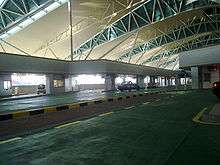Sultan Iskandar Building
The Sultan Iskandar Building or Bangunan Sultan Iskandar (BSI) (Jawi: باڠونن سلطان إسکندر) is a customs, immigration and quarantine (CIQ) complex in Johor Bahru, Johor, Malaysia. Located at the northern end of the Johor–Singapore Causeway, it is one of two land ports of entry to Malaysia on the Malaysia–Singapore border.
| Sultan Iskandar Building Bangunan Sultan Iskandar باڠونن سلطان إسکندر | |
|---|---|
| General information | |
| Type | Customs, Immigration and Quarantine (CIQ) Complex |
| Location | Bukit Chagar, Johor Bahru, Johor, Malaysia |
| Owner | Primary operators Government of Malaysia Malaysian Public Works Department (JKR) Secondary operators Department of Immigration Malaysia Royal Customs Department Malaysia Malaysian Road Transport Department PLUS Malaysia Berhad (Projek Lebuhraya Usahasama Berhad) Royal Malaysian Police Veterinary Service Department Ministry of Home Security Affairs Malaysian Timber Industrial Board Malaysian Fisheries Development Authority Federal Agricultural Marketing Authority Johor's State Land and Mines Office Perhilitan Johor's State Agriculture Department Johor's State Health Department Majlis Bandaraya Johor Bahru (MBJB) Tourism Malaysia |
| Design and construction | |
| Developer | Government of Malaysia Malaysian Public Works Department (JKR) Gerbang Perdana Sdn Bhd |
The building was named after the late Sultan Iskandar of Johor. Built as part of the Southern Integrated Gateway project on the former site of the Lumba Kuda flats, Kampung Bukit Chagar, the building occupies an area of 232,237 square metres (2,499,780 sq ft), making it the largest CIQ complex in Malaysia. The building started operations in 2008, replacing the former Johor Bahru CIQ Complex.
From Malaysia, the main expressway leading to the building is the Johor Bahru Eastern Dispersal Link Expressway. After border inspection, vehicles continue onto the Causeway to Woodlands Checkpoint in Woodlands, Singapore. Pedestrian access to the building is provided via the Johor Bahru Sentral railway station, which is linked to the building by a footbridge.
Components
Immigration Checkpoint

.jpg)
The immigration checkpoint has different checkpoints for bus passengers, bus drivers, lorries, motorcycles and cars. The checkpoint was designed with 38 counters for cars entering Malaysia, and 39 counters for those departing from Malaysia. There are 50 counters in each direction for motorcycles entering and departing Malaysia. The Secured Automated Clearance System for Malaysian Citizen Motorcyclists (M-BIKE) are provided here for all Malaysian citizen motorcyclists only, while foreigners can use Manual Counters for Motorcyclists.
Customs Checkpoint
At the customs checkpoint, 36 counters are designated for cars (20 for those arriving in Malaysia and 16 for those leaving the country) and 25 for motorcycles (17 for arrivals and 8 for departures).
Tolls
All toll transactions at the CIQ complex are conducted electronically with the use of a "Touch-N-Go" (TnG) Card Touch 'n Go ("Sentuh-dan-Jalan" in Malay). All foreign-registered vehicles embarking from the Singapore Woodlands checkpoint can purchase a TnG card at an old building on the left side of the causeway before approaching Johor.
The move to implement only electronic toll transactions at the new CIQ complex is part of a government strategy to urge the public to migrate to electronic toll transactions, as well as smooth the traffic flow at the CIQ complex.
The new CIQ complex is situated approximately 2 kilometres (1.2 mi) from the previous complex at the Johor Causeway. The complex is equipped with a customer service centre and reload lanes, which operate daily to enable the public to purchase, reload, or check their Touch-N-Go cards' prepaid balance.
An additional customer service centre is available at the old CIQ complex.
PLUS Expressways Toll Charges
(Starting 1 August 2014)
| Class | Type of vehicles | Inbound traffic Rate (in Malaysian ringgit (RM)) | Outbound traffic Rate (in Malaysian ringgit (RM)) |
|---|---|---|---|
| 0 | Motorcycle (Vehicles with two axles and two wheels) | None | None |
| 1 | Private Cars (Vehicles with two axles and three or four wheels (excluding taxi and bus)) | RM 2.90 | None |
| 2 | Vans and other small good vehicles (Vehicles with two axles and six wheels (excluding bus)) | RM 4.50 | None |
| 3 | Large Trucks (Vehicles with three or more axles (excluding bus)) | RM 6.10 | None |
| 4 | Taxis (Designated routes from Malaysia to Singapore) | RM 1.40 | None |
| 5 | Buses (Except public transport buses) | RM 2.30 | None |
- Note: Toll charges can only be paid with the Touch 'n Go card or RFID via TnG eWallet. Cash payment is not accepted.